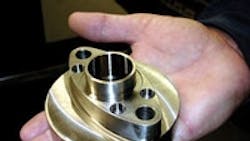Initially, lean thinking -- or multi-tasking -- was not the priority in Kim Parrish's mind. Parrish, general manager of Advanced Machining & Fabrication Inc., in Owasso, Okla., "simply needed to get more out of our equipment -- mostly conventional machines, turret lathes and such." By 2000 increasing orders motivated him into seriously considering lean training.
"We were pretty much operating as batch-and-queue, running 250 parts at a time through the shop. If problems surfaced, they tended to happen in the later operations, meaning we were scrapping entire runs when we caught mistakes. I started approaching lean pretty conventionally as a way to cut waste and keep quality high."
Parrish signed up for lean training just before the Sept. 11 attacks, a debacle that also led to canceled orders and managing in a business survival mode, he
recalls.
One of the first kaizen events Advanced ran with its lean consultant was for one of its energy services customers. "We formed a cell for short plugs and segment nuts," Parrish explains. "Machined from steel forgings, the parts are designed to allow a gas company to break into an existing line and redirect gas flow without shutting it down.
At the time Advanced already had a CNC turning center with live tooling, a milling spindle and Y-axis capability. "It can turn, drill and tap holes, face off the part front and back, and deliver a high-quality parts in one setup. But the consultant said the 13-minute cycle time was too long and that the three-machine cell was the way to go."
What finally discouraged Parrish with the cell approach was its high scrap rate on short runs. For example, consolidating short runs (five to 15 parts) with multi-tasking cut rates from 30% to more like 1%, says Parrish. "We have entered a new stage of thinking with multi-tasking." With one machine doing the work of three, Advanced is able to save on floor space and part travel. In addition, the company's four-fold increase in business has been achieved with a third less employees, adds Parrish.
See Also
